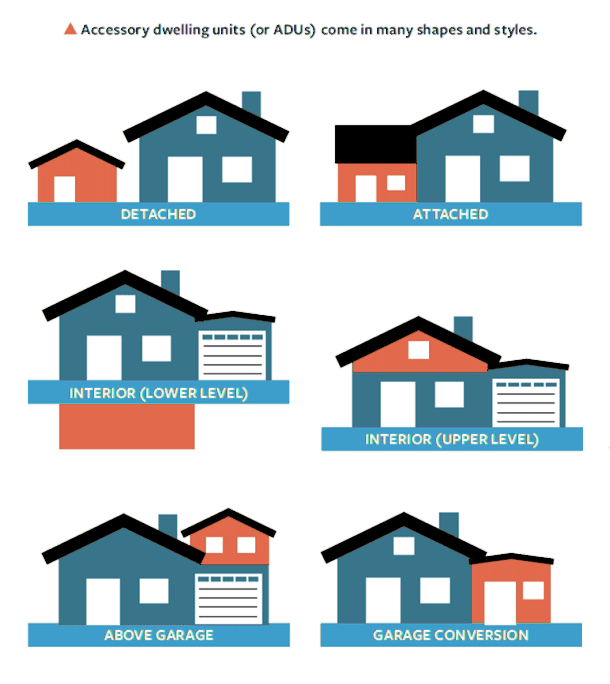ACCESSORY DWELLING UNITS (ADU)
MANZANITA PLANNING COMMISSION
Public Discussion Memo
March 4, 2021
In accordance with the requirements of Oregon Senate Bill 1051 passed by the Legislature in the 2017 session, Manzanita must allow accessory dwelling units (ADUs) in its urban growth area (UGB). The purpose of the ADU legislation is to address the lack of housing supply in Oregon by increasing the number of dwellings in a singlefamily residential zone.
An ADU is an independent residential living area that is on the same lot as a larger, primary dwelling, and has its own sleeping, cooking and bathroom facilities. The benefit of an ADU is that the development standards (such as for required parking and infrastructure) may be relaxed to accommodate ADUs. The City has a critical lack of affordable workforce housing, and sees ADUs as a viable option to increase available workforce and family care/independent living housing.
The City of Manzanita, including its urban growth area, does not have a singlefamily residential zone; however, the Planning Commission believes that standards for ADUs should be developed for the UGB so that development is not incompatible with currently existing City standards and is not overly restrictive within the UGB.
Background information on ADU standards.
ADUs can take several forms, which may require different standards.
ADUs can be attached to the primary home by constructing an addition or
converting space in existing structures such as a garage, attic, or basement, or they can be detached as a stand-alone unit.

The standards the Planning Commission can consider are related to ‘siting’ and ‘design’. Standards must be clear and objective.
Building code requirements are not considered by the Planning Commission, as they follow separate state mandates.
Siting Standards Under Consideration:
1. Number of units
- Only one primary residence and one ADU per R2, SRR, and RMD lot. All
residential zones already allow at least 2 dwelling units. The intention is
to not allow more density than the zoning code permits, but to relax
standards for 2nd dwelling. - No ADUs on lots with duplexes; conversions from duplex to ADU (and
vice versa) disallowed
2. Lot size; Lot coverage limits; Setbacks
- No minimum lot size for dwelling + ADU (no change)
- Maximum lot coverage standards apply (no change)
- There is some disagreement among PC members on setbacks.
Most prefer no change to existing setbacks; others would allow relaxed setback standards - ADUs may be located anywhere on lot within setbacks as determined
following public comment
3. Storm water
- Storm water runoff should follow Public Works standards
4. Nonconforming single-family dwellings
- Existing non-conforming structures may not increase nonconformance with the addition of an ADU
5. Parking
- The ADU legislation does not allow the City to require additional offstreet
parking for an ADU. - The required parking spaces for the primary dwelling cannot be
reduced by the addition of the ADU.
6. Utility connections
- The City only provides water. A separate water connection should not be required, but a separate water shut-off valve is recommended where possible.
7. System development charges (SDCs)
- Where possible, system development charges should be waived for the
ADU
8. Square floor area of ADU
- An attached or detached ADU can be no greater than 800 (900?) sq. ft. or 75% of the primary residence, whichever is smaller.
- No agreement was reached on the square foot % of an internal ADU.
Design Standards Under Consideration:
Manzanita’s zoning code does not perform a design review for residential dwellings.
We propose no standards for exterior materials, window orientation or dimensions, trim, or eaves, or ‘matching’ the design of the primary dwelling.
The following building standards apply:
1. Building height and roof pitch
- No changes to existing standards are recommended.
2. Entrances
- Only one entrance may be located on the street-facing façade of the
primary dwelling. - ADUs must have a separate entrance, except internal ADUs in
converted residences may use the same entrance as primary residence
3. Standards for distance and surface materials between ADU and dwelling may be developed following Public Safety recommendations.
4. Screening of outdoor storage and garbage areas is recommended.
Other Considerations:
1. Elements that an ADU should contain (kitchen, bathroom, etc.)
- The City’s definition of a ‘dwelling unit’ must be updated. Current language in 95-4 could allow for dwelling unit with no sink, toilet or bathing facility. Existing language is contrary to all model building codes as well as common sense.
- Proposed language supports definition as found in model residential building code:
i. Dwelling Unit. A single unit providing complete independent
living facilities for one or more persons including permanent
provisions for living, sleeping, eating, cooking and sanitation.
Dwelling units must be equipped with the following:
A. Cooking facility
B. Sink intended for meal preparation
C. Toilet
D. Shower or bathtub
2. Occupancy
- The Oregon Legislature prohibits a requirement that the property owner occupies one of the dwelling units with an ADU.
- Short Term Rentals should not be allowed in either the primary residence or in the ADU, as this would defeat the purpose of providing additional workforce or family care/independent living housing.
3. Address Numbers
- ADUs must have a separate address, meeting Public Safety standards
4. Building Code & Permitting
- New construction and conversions to ADU must follow all current
building code requirements. - Existing permitting and inspection standards apply.
- Smoke alarms and carbon monoxide alarms are required per building code.
5. Density calculations
- The Planning Commission has not reviewed density calculations for the applicable zones. If changes are recommended, they will be discussed in future hearings.
NEXT STEPS
The Planning Commission will incorporate public sentiment from today’s hearing on the above standards into its development of specific language for the Zoning Code (95-4) and the Comprehensive Plan.
Public hearing or hearings will be held again when specific changes to each section of the ordinance are developed before the Planning Commission makes a recommendation to the City Council forconsideration.
